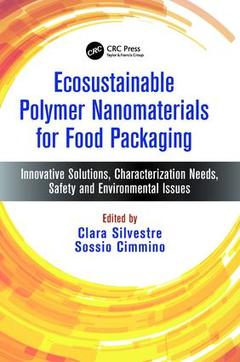Ecosustainable Polymer Nanomaterials for Food Packaging Innovative Solutions, Characterization Needs, Safety and Environmental Issues
Coordonnateurs : Silvestre Clara, Cimmino Sossio

Polymer nanotechnology offers exciting benefits to the food industry, including better materials for food packaging and safer foods on supermarket shelves with lower incidences of contamination. Ecosustainable Polymer Nanomaterials for Food Packaging: Innovative Solutions, Characterization Needs, Safety and Environmental Issues examines the complete life cycle of packaging based on polymer nanomaterials.
Focusing on current developments in nanomaterial packaging applications most likely to be accepted by consumers and attract regulatory attention in the immediate future, the book begins with a general introduction to current issues and future trends. The remaining chapters explore:
- The concept of "ethical design"?putting into practice key ideas such as the precautionary principle and presenting a model for accountability, responsibility, and ethical consideration
- The evolution of the rheology, structure, and morphology of nanomaterials with regard to processing conditions and constituents
- The application of plasma technologies for the production of barrier coatings on polymeric materials by nonequilibrium gas discharges
- Nanomaterials for food packaging developed from oil polymers (polyolefins) and from renewable resource polymers
- The use of cellulose nanowhiskers for food biopackaging and edible nano-laminate coatings
- The interactions of nanomaterials with food
- Examples of degradation under natural weathering, exposure, and recycling
The book concludes with a discussion on the use of polymer nanocomposite materials for food packaging applications. From raw material selection to properties characterization to marketing and disposal, the expert contributors consider the balance between cost and performance, risk and benefit, and health and environmental issues. They also identify barriers to progress that prevent a complete successful development of the new technology and recommend strategies for further advancement.
Polymer Nanomaterials for Food Packaging: Current Issues and Future Trends. Ethics, Communication, and Safety in the Use of PNFP. Evolution of Rheology, Structure, and Properties around the Rheological Flocculation and Percolation Thresholds in Polymer Nanocomposites. Characterization of Safe Nanostructured Polymeric Materials. Plasma Technology for Polymer Food Packaging Materials. Polypropylene and Polyethylene-Based Nanocomposites for Food Packaging Applications. Some Aspects Concerning the Nanomaterials from Renewable Resources Use in Food Packaging. Cellulose Nanowhiskers: Properties and Applications as Nanofillers in Nanocomposites with Interest in Food Biopackaging Applications. Edible Nano-Laminate Coatings for Food Applications. Potential Application of Nanomaterials in Food Packaging and Interactions of Nanomaterials with Food. Photodegradation of Poly(Lactic Acid)/Organo-Modified Clay Nanocomposites under Natural Weathering Exposure. Recycling of Nanocomposites. Polymer Nanocomposite Materials Used for Food Packaging. Index.
Date de parution : 10-2016
15.6x23.4 cm
Disponible chez l'éditeur (délai d'approvisionnement : 14 jours).
Prix indicatif 61,25 €
Ajouter au panierThèmes d’Ecosustainable Polymer Nanomaterials for Food Packaging :
Mots-clés :
MMT; Food Packaging; CNWs; polymer nanomaterials; Cloisite 30B; PLA Matrix; MMT Composite; SAXS Pattern; Neat PLA; iPP Composites; Food Packaging Applications; Percolation Threshold; WAXS Data; Food Contact Materials; Neat iPP; Oxygen Transmission Rate; MMT Nanocomposites; Water Vapor Permeability; MWCNT Loading; Barrier Properties; Polymer Matrix; Rheological Percolation Threshold; Food Packaging Materials; PLA Nanocomposites; PLA Composite; Low Nanotube Content



